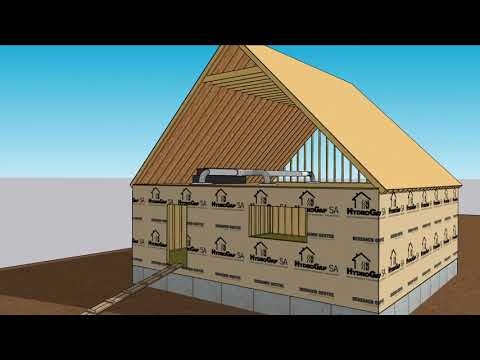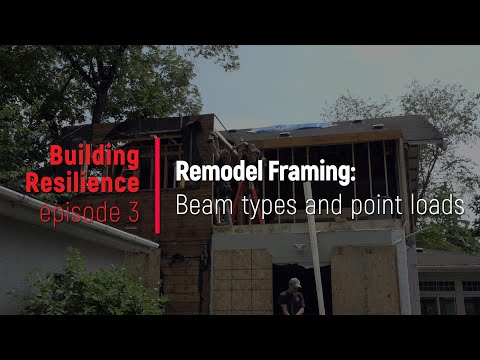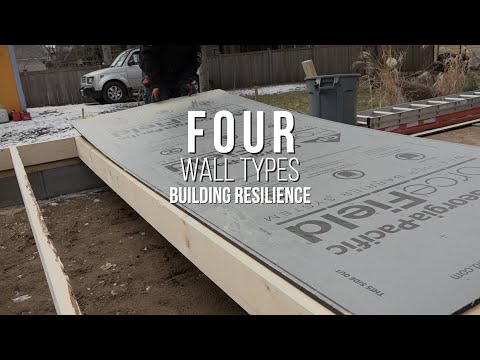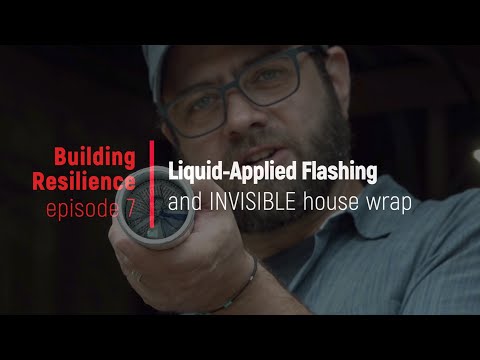Last time on Building Resilience, we were framing walls and roofs, sheathing them, and talking about beam types.
We find that we use a lot of PSLs, Parallel Strand Lumber. So they take these long strands, they line them all up so they’re going the same direction. and then they glue them up. The moisture content is extremely low.
What makes PSLs particularly interesting is that they are strong in multiple directions. They’re really great for columns, we use them a lot for posts. In fact, all of the major posts on this job are made from PSL.
You can also use them horizontally in either direction.
There were also a lot of jobsite jokes centered around wood, but we cut most of those out.
This week, we’re going to go under that framing to have a peek at a weak link in many building assemblies: crawlspaces. They’re often a source of moisture that can rot your house and poison your air.
Speaking of bad air, poorly detailed crawl spaces are also a neverending source of radon and soil gasses.
Eliminating those problems means sealing the crawlspace against moisture and also insulating it because cold surfaces create liquid water when they meet warm air.
There are two crawlspaces in this house that must be repaired
“I’m standing at the intersection between really old and a little bit old. This is 1910 and this is 2001. This is an addition that was put on by another builder. They attached it to the outside of the house. They built it with the best of intentions, but it’s a classic example of — to quote John Tooley,
“You can do the right thing the right way, you can do the right thing the wrong way, you can do the wrong thing the right way or you can do the wrong thing the wrong way, but only one of them is right.”
And this is an example of doing the wrong thing, the right way.
They used closed-cell spray foam, which isn’t a bad thing. The problem is the location that they placed it, which was between the floor joists with all of this exposed soil below it.
so we will actually be conditioning this space, which is what’s required by the code.
Install rigid foam to the crawlspace floor and walls, seal seams with a spray polyurethane froth-pack
The crawlspace under the old sunroom is accessible through a small hole inside. There’s not much headroom, there are a few posts supporting a beam, and the floor is lumpy.
The other is accessible from above, through the subfloor. We’re going to hide the floor framing, too, to make it easy to outline the plan. Both crawlspaces share the same solution: Styrofoam insulation and a spray polyurethane foam froth pack.
Begin with the floor, notching around posts, and piecing in as needed. Next, glue styrofoam sheets to the foundation walls and tape the seams tight. Also, tape the floor seams doing your best to get a good bond.
Now, you can seal the corners and edges with spray foam and then seal each seam on the floor and walls. When we put the framing back, we can see another important area for air sealing and insulation: the rim joist.
Seal this area also with spray foam making sure to encapsulate all of the pieces of the assembly from rim joist to styrofoam.
How to install styrofoam to the crawlspace floor and walls
Installing three-inch styrofoam to the floor and walls is pretty straightforward. You just cut it and plop it in place. It’s best if the floor is perfectly level, which it rarely is due to all kinds of obstructions.
Because we’re going to seal the seams with spray foam, the seams don’t need to be perfect. They should be good, though, because styrofoam is cheaper than spray foam.
You can cut Styrofoam panels with a utility knife, but for thick panels, like these two-inch sheets, it's easier to use a Skilsaw.
When the floor is complete, David turns to the walls, He uses construction adhesive on the backside, and then he sticks the panels to the foundation walls.
How to use a spray polyurethane froth-pack for crawlspace waterproofing and airsealing
After taping the seams, it’s time to seal up the connections with some spray foam in a froth-pack.
“Alright spray foam insulation. It’s a big part of how we build today, it’s one of the key ingredients in our building type.
Dupont happens to make something called froth-pack, which is a portable version, if you don’t need to foam an entire house.It comes in a red version and a green version, in a variety of different sizes.
What you need to know is that green is for air sealing and red is fire rated. So, if you’re doing a big crawlspace, it’s going to be red, if you’re doing weight pockets around windows, it’s going to be green.I don’t care how much you think you know about spray foam, always stop and read the instructions before you use any chemical product like this.
It’s not hard to use, but it is important that you use it safely and it’s got some specific steps that it walks you through before you use it.
If we open up the box of froth pack, inside we’re going to find a gun with two hoses, a series of nozzles, and two canisters: chemical A and chemical B. Chemical A is an isocyanite. Chemical B is a polyol. When the two come together, they create foam. The two chemicals travel independently through these two hoses until they reach the nozzle.
They give you two kinds of nozzles for two kinds of applications. The blue nozzle has a fan tip, for a large area like a rim joist or crawlspace.
The fill tip is for large openings, like weight pockets or large gaps.
Both tips have a spiral detail which keeps the chemicals separate until they get to the tip, where they mix and instantly start to react.
You get about 125-30 seconds between spray applications before you need to change the tip.
Plan ahead, know how you’ll move around the room, and if you stop for any period of time, be prepared to remove the nozzle, clean the gun, and put in a new nozzle. That process takes about a minute and a half. It’s not a big laborious process, but you will need to plan on switching out some tips.
Before applying the top to the gun, coat the inside of the gun threads with petroleum jelly, to prevent the spray foam from curing inside it.
“This is just petroleum jelly, the non-pharmecutical type. They want you to put it inside the threads so the foam doesn't stick to it. I also put it on the outside of my nozzle because sometimes foam blows back and I want to be able to clean my nozzel, and I can do that if I've got some jelly on there.
After Michael jellies up the tips, he climbs into his safety gear, just like it shows in the book:
- A Tyvek suit to protect skin and clothing
- An organic respirator to protect your lungs
- Gloves to protect your hands
And it’s into the crawlspace with him, where he skim coats the seams methodically working from the far corner back to the hole in the wall, strategically placing the box where he can hit targets without having to stop for more than the dreaded 30 seconds causing a tip change.
In the interest of moving quickly and thoroughly, he hits the rim joist assembly while he’s in the spot.
Now he can move to the more civilized crawlspace: the one with no subfloor above.
Again, he works from the far corner, across the back, hitting the wall seams and rim joist to the opposite end.
Then he moves back across the rim joist again, moving quickly but with a plan.
Now he moves back toward the front of the space, sealing the floor seams from one end to the other.
In the end, he fills in some wall foam that was excavated for some electrical work.
And then we watch the foam expand.
“…may have gone a little heavy there.”
And we’re ready to go heavy on next’s week’s adventure:
Out of the crawlspace and into the attic, where we’ll explore the effect of all of the air sealing we’re doing that’s out of sight:
We'll look at small mechanical system components targeted to the spaces they serve. In the attic, we’ll look at the air handler unit from Mitsubishi that cools the second floor, but the real treat is between the ceiling joists downstairs.
The EZ Fit Mini Split ceiling cassette is made for remodeling situations like this for bringing heat to or cool to places where it's difficult to run ductwork.
All that is next time on Building Resilience. Building Resilience is a production of the SGC Horizon media network. See all of season two here.











